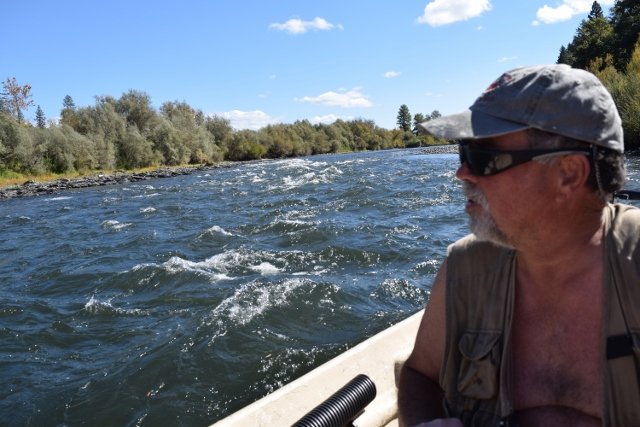Leaderboard
Popular Content
Showing content with the highest reputation on 02/12/2016 in all areas
-
I dont have a lot of faith in DNA versus a body. Small samples can be destroyed in one test. Which means that other labs cannot verify your work with tests of their own. Samples get contaminated or lost as well. DNA will absolutely do it if we can get through the hoops and loops. But a body bypasses all that. But if DNA is all you have???? Its light years ahead of a plaster cast or grainy photo. For the reasons you state in your first line: plaster casts or grainy photos are, if I am a scientist in a relevant field, far better than a DNA sample. For the latter I'll say: where's your type specimen? Don't have one? Contamination is my clear dismissal. I have to explain casts and photos. Experts have virtually verified that the provenance of Patty and many tracks is an unlisted species. The problem is that the society isn't holding science's feet to the fire for that alternative explanation...that they do not have. That evidence leaves clear markers that rule out a human as the subject, and make fakery such a farfetched explanation that it isn't one. DWA, Southern, and Norse can you expand your comments to improve clarity? If bigfoot were anything other than (technically) human, it would be divergent enough to be distinguishable in relatively small amounts of mtDNA. That would be one way to prove they exist with multiple biological samples. If my theory is right, being that I think that BF is from the genus homo and developed an entirely different survival strategy, then it's DNA may appear fully human but may have subtle (seemingly random) mutations that affect gene expression more than actual sequence which could look like ordinary human variation. Without deep study those kinds of things may never be fully identified. I have my doubts that if a specimen were in hand, we could persue the study of it unfettered. As soon as "human" DNA enters the picture, the ethics and protocol changes. Ownership of the specimen can then be challenged. Genetic sequence data then cannot be shared on a public data base without written consent of the donor which then blocks independent review. So you could prove it with a body, but you might not be able to keep it long enough..... Besides, the existence of wildmen is a crazy scary thing to drop on the world, even though Grizzly bears are likely more dangerous.2 points
-
FarArcher, Thanks for sharing your experiences and outlook on path forward. We still don't know what we are dealing with here with this creature. Whether it is malevolent or not, alpha predator or not, we still don't have any evidence that it has ever killed a human. Lots of rumors, innuendos, and the 411 books stirring the pot, but no evidence that a bigfoot has killed a human. It certainly has the capability and strength to kill humans; but does it have the intelligence to recognize the difference between food and cousins. I am not in the teddy bear, hug a BF camp; but neither am I on the camp that these creatures will kill you if you walk into their living area or are responsible for all the missing people in National Parks. I have read about bluff charges, scaring people by throwing rocks/sticks and by growling/screaming/howling. But, have not read a single report of somebody who got injured by a BF attack. Maybe 100% of those who got hit by a BF went missing; but that seems like a convenient excuse for a conspiracy. In this field, it is hard to draw any definitive conclusions on this mythical creature that should not exist. Explorer, I have a bit different perspective, and let me explain. I was a triple volunteer in the military, and knew for certain I was going into combat. I had the benefit of my instructors, who'd already been through multiple tours, but for two years, I asked almost every CIB holder, for three quick "Always do's" and three quick "Never do's." Hundreds. And hundreds. I heard a lot of things repeated, but I also got a lot of things that were uncommon. These replies I received were anecdotal. Every one of them. Yet the mountain of replies held truth. We're all familiar with the Trojan War. Told by Homer in the Illiad, and further written of in fragments by other writers, and written of by Roman poets Virgil and Ovid. Fantastic characters, fantastic stories, fantastic struggles, and it is all relegated to fantasy, legends, traditions, sagas, tales, and mythology. One of the more central mythical characters was Achilles. Well, an amateur actually found Troy. The real Troy. And it had been burned, built over multiple times, but the real Troy was discovered. It wasn't myth. Then, when Alexander crossed the Hellespont, we learn from Plutarch that he made a beeline for Troy, and made sacrifices to Minerva to honor those who died there, but especially the grave of Achilles, whose grave he anointed. Alexander had no trouble finding ruined Troy, nor the grave of the mythical Achilles. I think this is another example of narratives relegated to mythology, and yet when we look a bit closer, there's hard evidence to indicate that what was understood to be myth and anecdotes, in fact held truth. 'Bout this Bigfoot fellow. We find volumes of 'anecdotal' evidence, separated by decades, centuries, and millennia - told by separate peoples, cultures, nations, tribes, clans, and individuals, on different continents, regions, and terrains, called by many names - all reduced to the lowly title of anecdotal evidence. Many of these anecdotal narratives, by many cultures, over the millennia, separated by continents - all tell of a very dangerous creature, a creature many have actually warred against, ones whose names reflect them to be terrible cannibals, child stealers, child eaters, and woman stealers. So I'm supposed to ignore common sense, the preponderance of narratives over the millennia, and not draw any conclusions? Not assume these are potentially very dangerous? Not assume they are predators? Not assume they are predators of opportunity? Not assume they can even resort to cannibalism if the right, single opportunity arises simultaneously with a momentary need? I had a tiger that stalked a handful of us for three days and three nights. I killed it on the third night as it closed in - presumably to take one of us. On examination the following morning, I discovered it was an older tiger. Probably couldn't hunt very well. Probably discovered that man was an easy prey, and was bent on taking another. Maybe some older, maybe isolated, maybe outcast BF's on occasion when need and opportunity meet - will not hesitate to grab a lone person, or child - and meet an immediate need. Unfortunately, those loners who may have been taken - can't speak - can't provide direct evidence. Anyone wants to subscribe to the commonly accepted concept that these are passive, shy, generally non-confrontational - I say knock yourself out. Not me. When hundreds of narratives from disconnected peoples say the same thing - I'm taking THEIR word for it.1 point
-
1 point
-
I guess I don't understand. Are you wanting a habituation situation here or are you trying to figure out what could be doing this. As Norseman said, a camera would be most effective instead of guessing. If it isn't a bigfoot you'll be able to see what it is. As to figuring out how it could be done. Something small enough to slide down the wire yet heavy enough to pull the lid off while hanging on it would leave few marks. The wire is tied in the ring. Hang on the can and it will come off the lid. Sardines, think mink or weasel. They could easily climb those limbs. The fruit is knocked on the ground and a deer or something else comes along and eats it. I still have to ask what is the point of obliterating tracks when we call ourselves researchers? I'd like to hear a good reason. I've also seen a lot of speculation about BF being a scavenger. Anything eating carrion wouldn't have to worry about eating spoiled food.1 point
-
Hopefully someone like Norse will find a BF that died of old age so he won't be strapped with legal hassles. This is the easy part, then what do you do with it? After this sensation, how will BF be impacted? How will management of the national forest change? Here is my wife and I floating the Rogue River below Grants Pass Oregon. No BFs were seen but we looked for them and suppose they were sleeping in their beds.1 point
-
I saw it ... I had a heart attack ... I fell ... my rifle went off. ... ... Sorry Cops: Then how'd it get in the back of your truck? It was standing there when my rifle went off.1 point
-
1 point
-
Shoot Secure (refrigerate) Retain attorney Contact Meldrum Voila!1 point
-
Bottom line ... it depends on which state you are in. I've said this before. Guess someone didn't want to hear so I'll say it again. Some states list the protected animals and anything not specifically listed is "fair game" year around. Other states list the animals that can be killed and the conditions they can be killed under. In those states anything not specifically listed is automatically "protected." Know your state's laws. I believe, but won't swear, that California, where the Sierra Shooting was done, lists the things that can be killed. If so, Justin Smeja did indeed break the law. If it had been done here in Oregon it would have been legal unless there were some other illegal component ... shooting from or across a public road, shooting from a vehicle, hunting by prohibited methods (spotlight, for instance), or trespassing. Know your state's laws. (See, said it again.) Do not assume what is true in one state has any resemblance to what is legal in another. MIB1 point
-
Darn, need to invest in a trail cam pointed at your bait station!1 point
This leaderboard is set to New York/GMT-04:00












